-
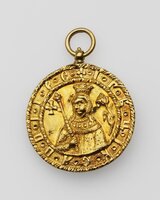 Medal Commemorating the Joint Reign of Ivan and Peter Under the Patronage of Sofia. Late 17th - Early 18th Century
Medal Commemorating the Joint Reign of Ivan and Peter Under the Patronage of Sofia. Late 17th - Early 18th Century
-
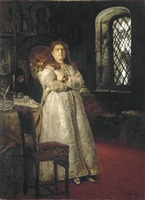 Princess Sofia Alexeyevna a Year after Her Incarceration in the Novodevichy Convent (during the Streltsy Execution and the Torturing of All Her Servants in 1698
Princess Sofia Alexeyevna a Year after Her Incarceration in the Novodevichy Convent (during the Streltsy Execution and the Torturing of All Her Servants in 1698
-
 Textile Panel
Textile Panel
-
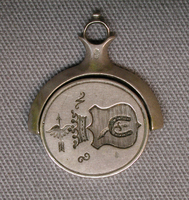 Swivel Seal
Swivel Seal
-
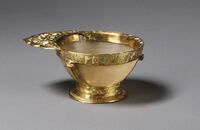 Charka
Charka
-
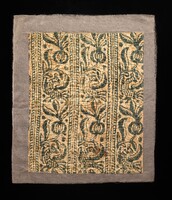 Textile Fragment
Textile Fragment
-
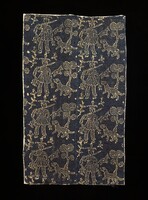 Textile fragment
Textile fragment
-
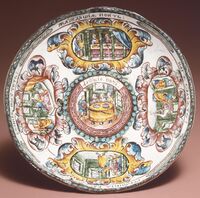 Bowl, 17th century
Bowl, 17th century
-
Metal Clock
Clock in the form of a flowering tree from the Amber Room.
-
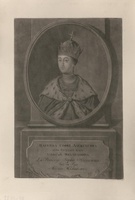 Portrait of Princess Sophia Alexeevna
Portrait of Princess Sophia Alexeevna
-
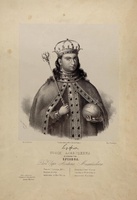 Portrait of Princess Sophia Alexeevna
Portrait of Princess Sophia Alexeevna
-
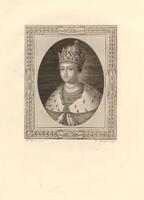 Portrait of Sophia Alekseyevna of Russia
Portrait of Sophia Alekseyevna of Russia Portrait of Sophia Alekseyevna of Russia; bust in profile to left, looking at the viewer, wearing an ermine-trimmed cloak fastened with a brooch, a multi-layered pearl necklace and a crown, her hair tied up; in an oval set inside a square frame decorated with foliage; after Henri Benner; state before letters
Stipple and etching
-
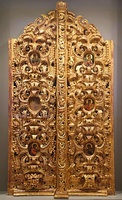 Royal Doors from Simonov Monastery
Royal Doors from Simonov Monastery Gilded doors carved in the early 1680s with icons from the first half of the 18th century.
-
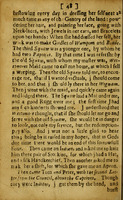 The Soveraignty & Goodness of God: Together, with the Faithfulness of His Promises Displayed: Being a Narrative of the Captivity and Restauration of Mrs. Mary Rowlandson: Commended by Her, to All That Desires to Know the Lords Doings to, and Dealings with Her: Especially to Her Dear Children and Relations (pg. 48)
The Soveraignty & Goodness of God: Together, with the Faithfulness of His Promises Displayed: Being a Narrative of the Captivity and Restauration of Mrs. Mary Rowlandson: Commended by Her, to All That Desires to Know the Lords Doings to, and Dealings with Her: Especially to Her Dear Children and Relations (pg. 48) ; "The possibility of Gods forsaking a people" with separate title page, imprint, pagination, and register ([6], 22 p.; A⁸ B⁶). Sometimes issued separately, according to ESTC.; Signatures: A-E⁸.; Title page within mourning border.; With: Rowlandson, Joseph. The possibility of Gods forsaking a people. Boston in New-England: Printed for John Ratcliffe, & John Griffin, 1682.; English short title catalogue, W15640; Evans, C. American bibliography, 332; Boston Public Library (Rare Books Department) copy H.15.8-9 bound in modern tan calfskin. Bookplate of the BPL Thomas Prince Library. Ownership inscription of Thomas Cotton[?] (here conjectured to be Thomas Cotton, 1653-1730) at head of title page. Bookplate of the New-England Library on title page verso, later inscribed with the date of Prince's last will and testament. Inscribed "T. Prince, Boston. The gift of Mrs. Deborah Burnit" on title page verso. Early manuscript correction on third line of page 52. Inscription in the hand of Thomas Prince on title page of The possibility of Gods forsaking a people: "but 2 days before he died (pref.)."
-
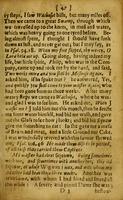 The Soveraignty & Goodness of God: Together, with the Faithfulness of His Promises Displayed: Being a Narrative of the Captivity and Restauration of Mrs. Mary Rowlandson: Commended by Her, to All That Desires to Know the Lords Doings to, and Dealings with Her: Especially to Her Dear Children and Relations (pg. 47)
The Soveraignty & Goodness of God: Together, with the Faithfulness of His Promises Displayed: Being a Narrative of the Captivity and Restauration of Mrs. Mary Rowlandson: Commended by Her, to All That Desires to Know the Lords Doings to, and Dealings with Her: Especially to Her Dear Children and Relations (pg. 47) The Soveraignty & Goodness of God: Together, with the Faithfulness of His Promises Displayed: Being a Narrative of the Captivity and Restauration of Mrs. Mary Rowlandson: Commended by Her, to All That Desires to Know the Lords Doings to, and Dealings with Her: Especially to Her Dear Children and Relations
-
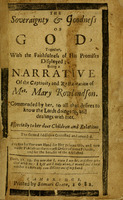 The Soveraignty & Goodness of God: Together, with the Faithfulness of His Promises Displayed: Being a Narrative of the Captivity and Restauration of Mrs. Mary Rowlandson: Commended by Her, to All That Desires to Know the Lords Doings to, and Dealings with Her: Especially to Her Dear Children and Relations (pg. 1)
The Soveraignty & Goodness of God: Together, with the Faithfulness of His Promises Displayed: Being a Narrative of the Captivity and Restauration of Mrs. Mary Rowlandson: Commended by Her, to All That Desires to Know the Lords Doings to, and Dealings with Her: Especially to Her Dear Children and Relations (pg. 1) Edition statement precedes statement of responsibility on title page.
; "The possibility of Gods forsaking a people" with separate title page, imprint, pagination, and register ([6], 22 p.; A⁸ B⁶). Sometimes issued separately, according to ESTC.; Signatures: A-E⁸.; Title page within mourning border.; With: Rowlandson, Joseph. The possibility of Gods forsaking a people. Boston in New-England: Printed for John Ratcliffe, & John Griffin, 1682.; English short title catalogue, W15640; Evans, C. American bibliography, 332; Boston Public Library (Rare Books Department) copy H.15.8-9 bound in modern tan calfskin. Bookplate of the BPL Thomas Prince Library. Ownership inscription of Thomas Cotton[?] (here conjectured to be Thomas Cotton, 1653-1730) at head of title page. Bookplate of the New-England Library on title page verso, later inscribed with the date of Prince's last will and testament. Inscribed "T. Prince, Boston. The gift of Mrs. Deborah Burnit" on title page verso. Early manuscript correction on third line of page 52. Inscription in the hand of Thomas Prince on title page of The possibility of Gods forsaking a people: "but 2 days before he died (pref.)."
-
 The Sudbury Bow
The Sudbury Bow From Peabody: Made from hickory, the bow measures over 5 feet high. An inscription on the bow reads: "The bow was taken from an Indian in Sudbury, Masstts A,D, 1660 by William Goodnough, who shot the Indian while he was ransacking his house for plunder." This description was interpreted literally, resulting in the title “The Sudbury Bow.” While the Indigenous maker of the bow is unknown, it is believed to be one of the only surviving examples of a seventeenth-century Native American bow. The bow was also used as inspiration for the bow depicted on the 1898 Seal of Massachusetts.
-
 The Soveraignty & Goodness of God: Together, with the Faithfulness of His Promises Displayed: Being a Narrative of the Captivity and Restauration of Mrs. Mary Rowlandson: Commended by Her, to All That Desires to Know the Lords Doings to, and Dealings with Her: Especially to Her Dear Children and Relations
The Soveraignty & Goodness of God: Together, with the Faithfulness of His Promises Displayed: Being a Narrative of the Captivity and Restauration of Mrs. Mary Rowlandson: Commended by Her, to All That Desires to Know the Lords Doings to, and Dealings with Her: Especially to Her Dear Children and Relations
-
The Present State of New-England. Being a Narrative of the Troubles with the Indians in New-England, from the First Planting Thereof in the Year 1607, to This Present Year 1677: But Cheifly of the Late Troubles in the Two Last Years 1675, and 1676. to Which Is Added a Discourse About the War with the Pequods in the Year 1637.
-
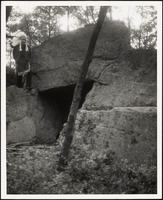 Gordon Hawes at King Philip's Cave off Mansfield St.
Gordon Hawes at King Philip's Cave off Mansfield St.
-
Collections of the Protestant Episcopal Historical Society for the Year 1851
-
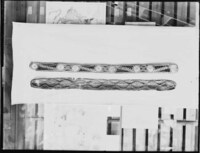 Belt -- Shown with the So-called King Philip Belt number 49333
Belt -- Shown with the So-called King Philip Belt number 49333
-
A New and Further Narrative of the State of New-England, Being a Continued Account of the Bloudy Indian-War, from March Till August, 1676.: Giving a Perfect Relation of the Several Devastations, Engagements, and Transactions There; as Also the Great Successes Lately Obtained Against the Barbarous Indians, the Reducing of King Philip, and the Killing of One of the Queens, &c. Together with a Catalogue of the Losses in the Whole, Sustained on Either Side, Since the Said War Began, as Near as Can Be Collected.
-
 A Map of New-England, Being the First That Ever Was Here Cut, and Done by the Best Pattern That Could Be Had, Which Being in Some Places Defective, It Made the Other Less Exact ; yet Doth It Sufficiently Shew the Scituation of the Countrey, and Conveniently Well the Distance of Places
A Map of New-England, Being the First That Ever Was Here Cut, and Done by the Best Pattern That Could Be Had, Which Being in Some Places Defective, It Made the Other Less Exact ; yet Doth It Sufficiently Shew the Scituation of the Countrey, and Conveniently Well the Distance of Places From Leventhal: This map was the first to be printed in the British Colonies, and though crude in appearance was for its time the best available map of the region. Based on a 1665 survey by Bostonian William Reed, it was repurposed by Foster to illustrate William Hubbard’s Narrative of the Troubles with the Indians in New England. The Narrative described King Philip’s War of 1675-76, a horrific conflict between New England colonists and Algonquin Indians. By war’s end the native population had been decimated and dozens of colonial towns (shown numbered on this map) ravaged.
-
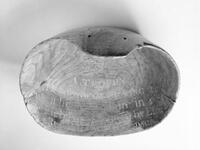 "King Philip's" bowl, Wampanoag Indians
"King Philip's" bowl, Wampanoag Indians
 Medal Commemorating the Joint Reign of Ivan and Peter Under the Patronage of Sofia. Late 17th - Early 18th Century
Medal Commemorating the Joint Reign of Ivan and Peter Under the Patronage of Sofia. Late 17th - Early 18th Century
 Princess Sofia Alexeyevna a Year after Her Incarceration in the Novodevichy Convent (during the Streltsy Execution and the Torturing of All Her Servants in 1698
Princess Sofia Alexeyevna a Year after Her Incarceration in the Novodevichy Convent (during the Streltsy Execution and the Torturing of All Her Servants in 1698
 Textile Panel
Textile Panel
 Swivel Seal
Swivel Seal
 Charka
Charka
 Textile Fragment
Textile Fragment
 Textile fragment
Textile fragment
 Bowl, 17th century
Bowl, 17th century
 Portrait of Princess Sophia Alexeevna
Portrait of Princess Sophia Alexeevna
 Portrait of Princess Sophia Alexeevna
Portrait of Princess Sophia Alexeevna
 Portrait of Sophia Alekseyevna of Russia Portrait of Sophia Alekseyevna of Russia; bust in profile to left, looking at the viewer, wearing an ermine-trimmed cloak fastened with a brooch, a multi-layered pearl necklace and a crown, her hair tied up; in an oval set inside a square frame decorated with foliage; after Henri Benner; state before letters Stipple and etching
Portrait of Sophia Alekseyevna of Russia Portrait of Sophia Alekseyevna of Russia; bust in profile to left, looking at the viewer, wearing an ermine-trimmed cloak fastened with a brooch, a multi-layered pearl necklace and a crown, her hair tied up; in an oval set inside a square frame decorated with foliage; after Henri Benner; state before letters Stipple and etching Royal Doors from Simonov Monastery Gilded doors carved in the early 1680s with icons from the first half of the 18th century.
Royal Doors from Simonov Monastery Gilded doors carved in the early 1680s with icons from the first half of the 18th century. The Soveraignty & Goodness of God: Together, with the Faithfulness of His Promises Displayed: Being a Narrative of the Captivity and Restauration of Mrs. Mary Rowlandson: Commended by Her, to All That Desires to Know the Lords Doings to, and Dealings with Her: Especially to Her Dear Children and Relations (pg. 48) ; "The possibility of Gods forsaking a people" with separate title page, imprint, pagination, and register ([6], 22 p.; A⁸ B⁶). Sometimes issued separately, according to ESTC.; Signatures: A-E⁸.; Title page within mourning border.; With: Rowlandson, Joseph. The possibility of Gods forsaking a people. Boston in New-England: Printed for John Ratcliffe, & John Griffin, 1682.; English short title catalogue, W15640; Evans, C. American bibliography, 332; Boston Public Library (Rare Books Department) copy H.15.8-9 bound in modern tan calfskin. Bookplate of the BPL Thomas Prince Library. Ownership inscription of Thomas Cotton[?] (here conjectured to be Thomas Cotton, 1653-1730) at head of title page. Bookplate of the New-England Library on title page verso, later inscribed with the date of Prince's last will and testament. Inscribed "T. Prince, Boston. The gift of Mrs. Deborah Burnit" on title page verso. Early manuscript correction on third line of page 52. Inscription in the hand of Thomas Prince on title page of The possibility of Gods forsaking a people: "but 2 days before he died (pref.)."
The Soveraignty & Goodness of God: Together, with the Faithfulness of His Promises Displayed: Being a Narrative of the Captivity and Restauration of Mrs. Mary Rowlandson: Commended by Her, to All That Desires to Know the Lords Doings to, and Dealings with Her: Especially to Her Dear Children and Relations (pg. 48) ; "The possibility of Gods forsaking a people" with separate title page, imprint, pagination, and register ([6], 22 p.; A⁸ B⁶). Sometimes issued separately, according to ESTC.; Signatures: A-E⁸.; Title page within mourning border.; With: Rowlandson, Joseph. The possibility of Gods forsaking a people. Boston in New-England: Printed for John Ratcliffe, & John Griffin, 1682.; English short title catalogue, W15640; Evans, C. American bibliography, 332; Boston Public Library (Rare Books Department) copy H.15.8-9 bound in modern tan calfskin. Bookplate of the BPL Thomas Prince Library. Ownership inscription of Thomas Cotton[?] (here conjectured to be Thomas Cotton, 1653-1730) at head of title page. Bookplate of the New-England Library on title page verso, later inscribed with the date of Prince's last will and testament. Inscribed "T. Prince, Boston. The gift of Mrs. Deborah Burnit" on title page verso. Early manuscript correction on third line of page 52. Inscription in the hand of Thomas Prince on title page of The possibility of Gods forsaking a people: "but 2 days before he died (pref.)." The Soveraignty & Goodness of God: Together, with the Faithfulness of His Promises Displayed: Being a Narrative of the Captivity and Restauration of Mrs. Mary Rowlandson: Commended by Her, to All That Desires to Know the Lords Doings to, and Dealings with Her: Especially to Her Dear Children and Relations (pg. 47) The Soveraignty & Goodness of God: Together, with the Faithfulness of His Promises Displayed: Being a Narrative of the Captivity and Restauration of Mrs. Mary Rowlandson: Commended by Her, to All That Desires to Know the Lords Doings to, and Dealings with Her: Especially to Her Dear Children and Relations
The Soveraignty & Goodness of God: Together, with the Faithfulness of His Promises Displayed: Being a Narrative of the Captivity and Restauration of Mrs. Mary Rowlandson: Commended by Her, to All That Desires to Know the Lords Doings to, and Dealings with Her: Especially to Her Dear Children and Relations (pg. 47) The Soveraignty & Goodness of God: Together, with the Faithfulness of His Promises Displayed: Being a Narrative of the Captivity and Restauration of Mrs. Mary Rowlandson: Commended by Her, to All That Desires to Know the Lords Doings to, and Dealings with Her: Especially to Her Dear Children and Relations The Soveraignty & Goodness of God: Together, with the Faithfulness of His Promises Displayed: Being a Narrative of the Captivity and Restauration of Mrs. Mary Rowlandson: Commended by Her, to All That Desires to Know the Lords Doings to, and Dealings with Her: Especially to Her Dear Children and Relations (pg. 1) Edition statement precedes statement of responsibility on title page. ; "The possibility of Gods forsaking a people" with separate title page, imprint, pagination, and register ([6], 22 p.; A⁸ B⁶). Sometimes issued separately, according to ESTC.; Signatures: A-E⁸.; Title page within mourning border.; With: Rowlandson, Joseph. The possibility of Gods forsaking a people. Boston in New-England: Printed for John Ratcliffe, & John Griffin, 1682.; English short title catalogue, W15640; Evans, C. American bibliography, 332; Boston Public Library (Rare Books Department) copy H.15.8-9 bound in modern tan calfskin. Bookplate of the BPL Thomas Prince Library. Ownership inscription of Thomas Cotton[?] (here conjectured to be Thomas Cotton, 1653-1730) at head of title page. Bookplate of the New-England Library on title page verso, later inscribed with the date of Prince's last will and testament. Inscribed "T. Prince, Boston. The gift of Mrs. Deborah Burnit" on title page verso. Early manuscript correction on third line of page 52. Inscription in the hand of Thomas Prince on title page of The possibility of Gods forsaking a people: "but 2 days before he died (pref.)."
The Soveraignty & Goodness of God: Together, with the Faithfulness of His Promises Displayed: Being a Narrative of the Captivity and Restauration of Mrs. Mary Rowlandson: Commended by Her, to All That Desires to Know the Lords Doings to, and Dealings with Her: Especially to Her Dear Children and Relations (pg. 1) Edition statement precedes statement of responsibility on title page. ; "The possibility of Gods forsaking a people" with separate title page, imprint, pagination, and register ([6], 22 p.; A⁸ B⁶). Sometimes issued separately, according to ESTC.; Signatures: A-E⁸.; Title page within mourning border.; With: Rowlandson, Joseph. The possibility of Gods forsaking a people. Boston in New-England: Printed for John Ratcliffe, & John Griffin, 1682.; English short title catalogue, W15640; Evans, C. American bibliography, 332; Boston Public Library (Rare Books Department) copy H.15.8-9 bound in modern tan calfskin. Bookplate of the BPL Thomas Prince Library. Ownership inscription of Thomas Cotton[?] (here conjectured to be Thomas Cotton, 1653-1730) at head of title page. Bookplate of the New-England Library on title page verso, later inscribed with the date of Prince's last will and testament. Inscribed "T. Prince, Boston. The gift of Mrs. Deborah Burnit" on title page verso. Early manuscript correction on third line of page 52. Inscription in the hand of Thomas Prince on title page of The possibility of Gods forsaking a people: "but 2 days before he died (pref.)." The Sudbury Bow From Peabody: Made from hickory, the bow measures over 5 feet high. An inscription on the bow reads: "The bow was taken from an Indian in Sudbury, Masstts A,D, 1660 by William Goodnough, who shot the Indian while he was ransacking his house for plunder." This description was interpreted literally, resulting in the title “The Sudbury Bow.” While the Indigenous maker of the bow is unknown, it is believed to be one of the only surviving examples of a seventeenth-century Native American bow. The bow was also used as inspiration for the bow depicted on the 1898 Seal of Massachusetts.
The Sudbury Bow From Peabody: Made from hickory, the bow measures over 5 feet high. An inscription on the bow reads: "The bow was taken from an Indian in Sudbury, Masstts A,D, 1660 by William Goodnough, who shot the Indian while he was ransacking his house for plunder." This description was interpreted literally, resulting in the title “The Sudbury Bow.” While the Indigenous maker of the bow is unknown, it is believed to be one of the only surviving examples of a seventeenth-century Native American bow. The bow was also used as inspiration for the bow depicted on the 1898 Seal of Massachusetts. The Soveraignty & Goodness of God: Together, with the Faithfulness of His Promises Displayed: Being a Narrative of the Captivity and Restauration of Mrs. Mary Rowlandson: Commended by Her, to All That Desires to Know the Lords Doings to, and Dealings with Her: Especially to Her Dear Children and Relations
The Soveraignty & Goodness of God: Together, with the Faithfulness of His Promises Displayed: Being a Narrative of the Captivity and Restauration of Mrs. Mary Rowlandson: Commended by Her, to All That Desires to Know the Lords Doings to, and Dealings with Her: Especially to Her Dear Children and Relations
 Gordon Hawes at King Philip's Cave off Mansfield St.
Gordon Hawes at King Philip's Cave off Mansfield St.
 Belt -- Shown with the So-called King Philip Belt number 49333
Belt -- Shown with the So-called King Philip Belt number 49333
 A Map of New-England, Being the First That Ever Was Here Cut, and Done by the Best Pattern That Could Be Had, Which Being in Some Places Defective, It Made the Other Less Exact ; yet Doth It Sufficiently Shew the Scituation of the Countrey, and Conveniently Well the Distance of Places From Leventhal: This map was the first to be printed in the British Colonies, and though crude in appearance was for its time the best available map of the region. Based on a 1665 survey by Bostonian William Reed, it was repurposed by Foster to illustrate William Hubbard’s Narrative of the Troubles with the Indians in New England. The Narrative described King Philip’s War of 1675-76, a horrific conflict between New England colonists and Algonquin Indians. By war’s end the native population had been decimated and dozens of colonial towns (shown numbered on this map) ravaged.
A Map of New-England, Being the First That Ever Was Here Cut, and Done by the Best Pattern That Could Be Had, Which Being in Some Places Defective, It Made the Other Less Exact ; yet Doth It Sufficiently Shew the Scituation of the Countrey, and Conveniently Well the Distance of Places From Leventhal: This map was the first to be printed in the British Colonies, and though crude in appearance was for its time the best available map of the region. Based on a 1665 survey by Bostonian William Reed, it was repurposed by Foster to illustrate William Hubbard’s Narrative of the Troubles with the Indians in New England. The Narrative described King Philip’s War of 1675-76, a horrific conflict between New England colonists and Algonquin Indians. By war’s end the native population had been decimated and dozens of colonial towns (shown numbered on this map) ravaged. "King Philip's" bowl, Wampanoag Indians
"King Philip's" bowl, Wampanoag Indians